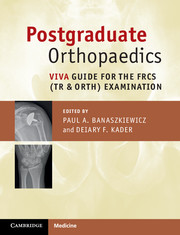Book contents
- Frontmatter
- Contents
- List of Contributors
- Foreword
- Preface
- Section 1 The FRCS (Tr & Orth) Oral Examination
- Section 2 Adult Elective Orthopaedics and Spine
- Section 3 Trauma
- Section 4 Hand and Upper Limb/Children's Orthopaedics
- Section 5 Applied Basic Science
- Section 6 Diagrams for the FRCS (Tr & Orth)
- Index
- Plate Section
Preface
Published online by Cambridge University Press: 05 November 2012
- Frontmatter
- Contents
- List of Contributors
- Foreword
- Preface
- Section 1 The FRCS (Tr & Orth) Oral Examination
- Section 2 Adult Elective Orthopaedics and Spine
- Section 3 Trauma
- Section 4 Hand and Upper Limb/Children's Orthopaedics
- Section 5 Applied Basic Science
- Section 6 Diagrams for the FRCS (Tr & Orth)
- Index
- Plate Section
Summary
This book has been written specifically to guide candidates better through the FRCS (Trauma and Orthopaedic) viva exam or structured oral examination, as the Intercollegiate Specialty Board (ISB) prefers to call it.
The oral exam is regarded by many as a poor relative of the clinicals; the intermediate and short cases being the most difficult part of the exam to pass and the section most candidates tend to fail.
Despite this the oral part of the exam should not be underestimated. The often-heard mutterings that the orals are fairly straightforward to pass can lull candidates into a false sense of security.
Candidates with good core knowledge may still end up failing one or more oral sections if technique is poor.
The book takes the form of the major four oral sections of the examination, namely adult elective orthopaedics, trauma, hand and upper limb/children’s orthopaedics and applied basic science. There is an introduction section on general guidance and a chapter dealing with common diagrams that you may be asked to draw out in the examinations.
We have tried to pitch the oral dialogue at the standard of a good to outstanding pass believing that more is better than less. By way of comparison we occasionally include a poor substandard answer from a candidate. More often you learn more from the viva answers that go wrong than from questions that don’t challenge you.
- Type
- Chapter
- Information
- Postgraduate OrthopaedicsViva Guide for the FRCS (Tr & Orth) Examination, pp. ix - xPublisher: Cambridge University PressPrint publication year: 2012

